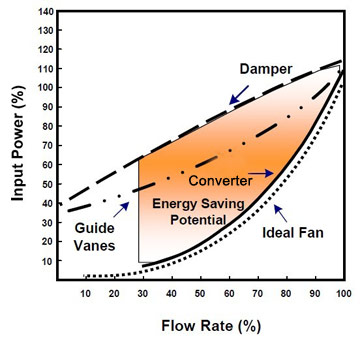Fans play a crucial role in powering VOCs control systems. In various settings like factories, large industrial facilities, and even restaurant kitchens, fans employed in boilers utilize inverters. But why opt for inverters in fan systems?
It’s common knowledge that many VOCs exhaust air ducts have valves to control the exhaust air outlet’s size—mechanical valves, solenoid valves, etc. These valves serve to control the pipe size for achieving the desired air volume. However, they fall short in delivering energy-saving benefits due to a lack of variation. During fan operation, the exhaust fan consistently runs at the power frequency, resulting in ongoing electricity consumption without achieving significant energy-saving effects.
The annual electricity consumption of fan equipment makes up approximately one-third of the national electricity consumption. The primary factor contributing to this scenario is the traditional adjustment technique employed for fan equipment, which involves adjusting the air supply volume. This is achieved by adjusting the baffles and valve openings either at the inlet or outlet. A large amount of water is consumed in the process of shutting off baffles and valves.
Since most fans have square torque loads, the shaft power exhibits a cubic relationship with rotational speed. Consequently, a significant decrease in power consumption occurs when the fan’s rotation speed decreases. This implies a large potential for energy savings. The most efficient energy-saving measure involves the use of a variable frequency speed regulator. By adjusting the flow and air volume and applying a variable frequency converter (professional manufacturer of various VOCs management RTO, RCO, CO, condenser, spray tower, activated carbon/ resin/ zeolite adsorption and desorption equipment: Fan 13141458653 WeChat), the power-saving rate generally ranges from 20% to 50%. In many designs, the user’s wind turbine capacity is often designed to be much higher than the actual need, leading to a ” big horse and small cart” phenomenon, which is inefficient and results in a lot of waste of electric energy. Therefore, the benefits of promoting AC variable frequency speed regulating devices are significant.

The installation of frequency converters on fans offers several advantages:
Adjustable Air Volume: The fan frequency converter can adjust the air volume of the fan by changing the speed of the fan to adapt to the needs of production work.
Soft Start Feature: With a frequency converter installed, the fan can achieve a slow start. Soft start and slow start can reduce the impact on the power grid and extend the service life of the equipment.
Energy-Efficient Operation: The fan frequency converter adjusts the air volume through the temperature sensor to save energy and effectively improve quality and work efficiency.
Enhanced Protection Functions: Equipping the fan with a frequency converter provides comprehensive protection functions, ensuring high reliability, a low failure rate, and reducing the workload for maintenance personnel.
Noise Reduction: The addition of a frequency converter effectively reduces fan noise, particularly beneficial in applications like kitchen fans where noise reduction is crucial.




